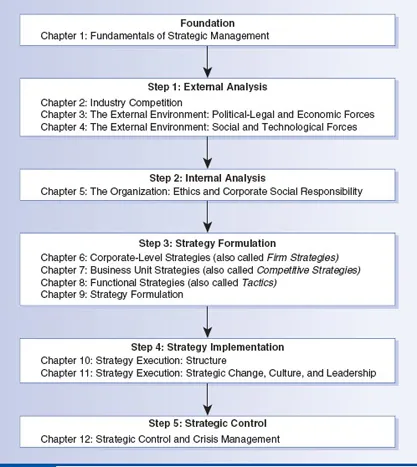![]()
Chapter Outline
What Is Strategic Management?
Intended and Realized Strategies
Scientific and Artistic Perspectives on Strategic Management
Influence on Strategic Management
Corporate Governance and Boards of Directors
Strategic Decisions
The Global Imperative
Summary
Key Terms
Review Questions and Exercises
Practice Quiz
Student Study Site
Notes
chapter 1
Fundamentals of Strategic Management
What do Circuit City, Washington Mutual, Saab, Blockbuster, and Borders have in common? All of these recognized companies filed for bankruptcy during the past several years. While the situation surrounding each firm is different, all of them failed to meet various strategic challenges. Put another way, organizations typically do not succeed or fail randomly. Some plan, prepare, and execute more effectively than others.
Today’s business world is global, Internet-driven, and obsessed with speed. The challenges it creates for strategic managers are often complex, ambiguous, and unstructured. Add to this the incessant allegations of top management wrongdoings, economic stagnation, and increasing executive compensation, and it is easy to see why firm leaders are under great pressure to respond to strategic problems quickly, decisively, and responsibly. Indeed, the need for effective strategic management has never been more pronounced. This text presents a framework for addressing today’s strategic challenges.
This chapter introduces the notion of strategic management, highlights its importance, and presents a five-step process for strategically analyzing an organization. The remaining chapters expand on the various steps in the process with special emphasis on their application to ongoing enterprises.
What Is Strategic Management? ________________
Organizations exist for a purpose. The mission is articulated in a broadly defined but enduring statement of purpose that identifies the scope of an organization’s operations and its offerings to affected groups and entities. Most organizations of a significant size or stature have developed a formal mission statement, a concept discussed further in Chapter 5.
Strategy refers to top management’s plans to develop and sustain competitive advantage—a state whereby a firm’s successful strategies cannot be easily duplicated by its competitors1—so that the organization’s mission is fulfilled.2 Following this definition, it is assumed that an organization has a plan, its competitive advantage is understood, and its members understand the reason for its existence. These assumptions may appear self-evident, but many strategic problems can be traced to fundamental misunderstandings associated with defining the strategy. Debates over the nature of the organization’s competitive advantage, its mission, and whether or not a strategic plan is really needed can be widespread.3 As such, comments such as “We’re too busy to focus on developing a strategy” or “I’m not exactly sure what my company is really trying to accomplish” can be overheard in many organizations.
Strategic management is a broader term than strategy and is a process that includes top management’s analysis of the environment in which the organization operates prior to formulating a strategy, as well as the plan for implementation and control of the strategy. The difference between a strategy and the strategic management process is that the latter includes considering what must be done before a strategy is formulated through assessing whether or not the success of an implemented strategy was successful. The strategic management process can be summarized in five steps, each of which is discussed in greater detail in subsequent chapters of the book (see Figure 1.1):4
- External Analysis: Analyze the opportunities and threats, or constraints, that exist in the organization’s external environment, including industry and forces in the external environment.
- Internal Analysis: Analyze the organization’s strengths and weaknesses in its internal environment. Consider the context of managerial ethics and corporate social responsibility.
- Strategy Formulation: Formulate strategies that build and sustain competitive advantage by matching the organization’s strengths and weaknesses with the environment’s opportunities and threats.
- Strategy Execution: Implement the strategies that have been developed.
- Strategic Control: Measure success and make corrections when the strategies are not producing the desired outcomes.
The sequential order of the steps is logical. A thorough understanding of the organization and its environment is essential if the appropriate strategy is to be developed, put into action, and controlled. One could transpose the first two steps and analyze the internal environment before the external environment—the logic being that comprehending the organization informs the strategic assessment of factors outside of the firm. The external environment is analyzed before the internal environment in Figure 1.1, however, because internal goals, resources, and competencies are viewed in a relative fashion to some extent and are understood within the context of the industry and the factors that drive it. This dilemma resembles the chicken and egg argument; in a practical sense, external and internal analysis often occurs simultaneously.
A distinction between outside and inside perspectives on strategy is also relevant. Outsiders analyzing a firm should apply a systematic approach that progresses through these steps in order. Doing so develops a holistic understanding of the firm, its industry, and its strategic challenges.
Inside organizations, strategies are being formulated, implemented, and controlled simultaneously while external and internal factors are continually reassessed. In addition, changes in one stage of the strategic management process will inevitably affect other stages as well. After a planned strategy is implemented, it often requires modification as conditions change. Hence, because these steps are so tightly intertwined, insiders tend to treat all of the steps as a single integrated, ongoing process.5
Figure 1.1 Organization of the Book.
Consider the strategic management process at a fast-food restaurant chain. At any given time, top managers are likely assessing changes in consumer taste preferences and food preparation, analyzing the activities of competitors, working to overcome firm weaknesses, controlling remnants of a strategy implemented several years ago, implementing a strategy crafted months earlier, and formulating strategic plans for the future. Although each of these activities can be linked to a distinct stage in the strategic management process, they occur simultaneously.
An effective strategy is built on the foundation of the organization’s business model, the mechanism whereby the organization seeks to earn a profit by selling its goods or services. While all firms seek to produce a product or service and sell it at a price higher than its production and overhead costs, a business model is stated in greater detail. For example, a magazine publisher might adopt a subscription model, an advertising model, or perhaps some combination of the two. Profits would be generated primarily from readers under the subscription model but from advertisers under the advertising model. As we can see, identifying a firm’s business model can become more complex when intricate details are considered. Progressive firms often devise innovative business models that extract revenue—and ultimately profits—from sources not identified by competitors.
Consider the razor and blades business model invented by Gillette. A company gives away or deeply discounts a product—the razor—while planning to profit from future sales of required replacement or complementary products—the blades. Cell phones are often given to customers willing to sign a 2-year service contract. Computer printers are typically sold below production cost, but customers must periodically replace the ink cartridges, which are high-margin items. This model is not foolproof, however. In a competitive marketplace, customers may be able to purchase the required complementary products at lower prices from rivals not under pressure to recoup initial losses.
Successful business models can change over time. Since the early 2000s, a number of authors have strayed from the traditional business model whereby book publishers offer contracts and pay royalties of 10% to 15%. Leveraging advances in publishing software, social media, and a strong online retail book market, they have opted for a self-publishing model. Enterprising authors who publish their own work also shoulder the initial risk but can net as much as a 70% return on e-book sales from companies such as Amazon.com. The total print book and e-book output of self-publishers in the United States rose from about 50,000 titles in 2006 to over 125,000 in 2010.6
While a successful strategy is built on the firm’s business model, crafting one can be a challenge. Realistically, a number of factors are typically associated with successful strategies. Some of these factors including the following:
- The organization’s competitive environment is well understood, in detail.
- Strengths and weaknesses are assessed in a thorough and realistic manner.
- The strategy is consistent with the mission and goals of the organization.
- Plans for putting the strategy into action are designed with specificity before it is implemented.
- Possible future changes in the proposed strategy—a process called strategic control—are evaluated before the strategy is adopted.
Careful consideration of these factors reinforces the interrelatedness of the steps in the strategic management process. Each factor is most closely associated with one of the five steps, yet they fit together like pieces of a puzzle. The details associated with the success factors—and others—will be discussed in greater detail in subsequent chapters.
While some of these success factors are associated with the competitive environment in profit-seeking firms, strategic management is not limited to for-profit organizations. Top managers of any organization, regardless of profit or nonprofit status, must understand the organization’s environment and its capabilities and develop strategies to assist the enterprise in attaining its goals. Former Drexel University president Constantine Papadakis, for example, was widely considered to be a leading strategic thinker among university top executives. The innovative Greek immigrant promoted Drexel through aggressive marketing, while campaigning for an all-digital library without books. In many respects, he managed the university in the same way that other executives manage profit-seeking enterprises. His annual salary was close to $1,000,000 in the years preceding his death in 2009, making him one of the highest paid university presidents in the country.7
Intended and Realized Strategies
One of the most critical challenges facing organizations is the reality that strategies are not always implemented as originally planned. Sometimes strategic decisions seem to evolve. In this respect, strategy formulation can be seen as an iterative process where decision makers take actions, make sense of those actions afterward, and then decide how to proceed.
Henry Mintzberg introduced two terms to help clarify the shift that often occurs between the time a strategy is formulated and the time it is implemented...


